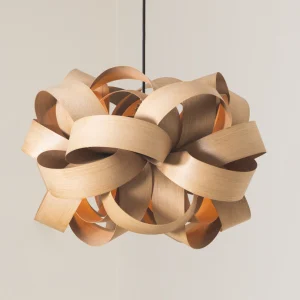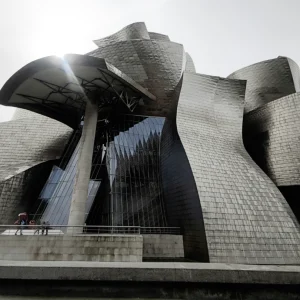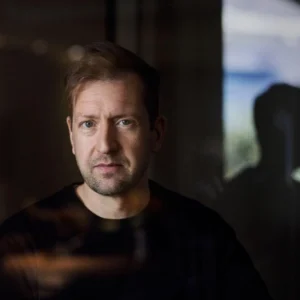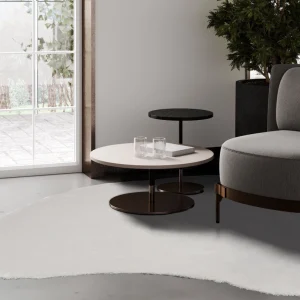I LOVE A GOOD conversation – the more free-range the better, complete with serendipitous and intuitive turns and twists. Which may be one of the reasons why, as a writer across art, design and architecture, I take particular pleasure from a good site-responsive installation. It brings all my favourite disciplines together: the artist’s work dialoguing with your own thoughts, emotions and senses, but also with the interior and architectural setting and its wider context.
Two of the most memorable and fascinating ‘conversations’ I have witnessed this summer are by two very different artists in two contrasting sites. One was a place of worship, built by an architectural legend, to serve a city that is drenched in beauty; a city that has arguably been at the centre of an elite, aesthetic universe for the past 700 or so years, for which privilege it is now deluged with gawping tourists. Th e other was an extraordinary, opulent, Victorian mansion, built as a bespoke home for a wealthy aristocratic family, on an island on the west coast of Scotland – well off the mainstream tourist trail.
Belgian artist Berlinda de Bruyckere was commissioned this year to create work for the Basilica of the San Giorgio Maggiore church in Venice, designed by the supreme renaissance architect Andrea Palladio (1508-1580) in 1566 and completed after his death in 1580. Its white walls create a wonderful setting for the Tintorettos and assorted statues and devotional icons placed around this cavernous structure.
 De Bruyckere’s Arcangeli are part of the City of Refuge III exhibition, at the Abbazia di San Giorgio Maggiore. It is a Collateral Event of the 60th International Art Exhibition – La Biennale di Venezia © Berlinde De Bruyckere. Courtesy the artist and Hauser & Wirth
De Bruyckere’s Arcangeli are part of the City of Refuge III exhibition, at the Abbazia di San Giorgio Maggiore. It is a Collateral Event of the 60th International Art Exhibition – La Biennale di Venezia © Berlinde De Bruyckere. Courtesy the artist and Hauser & Wirth
They also create a stunning backdrop for de Bruyckere’s Arcangeli, three human-scale figures, their heads shrouded in waxed blankets, shreds of which dangle around their legs. Th ese fleshy, life-sized figures look wounded, dirty, evoking suffering but also humanity. They are placed for maximum impact around the nave and side aisles, supported on rough plinths, one made of rusted metal; another’s timber base is burnished with silver paint. Other ‘accessories’ to the Arcangeli include a timber frame draped in swagged cloth and carpet, and assorted mirror-polished metal panels. These roughhewn, everyday textures bring an ordinary, domestic quality into this temple of reverence.
But they also bring something more: the bunched folds and creases of de Bruyckere’s swagging sculpture dialogue with the beautifully rendered, painted or sculpted robes of the religious scenes and figures nearby; the gleaming silvery paint on rough wood plinths shines in sympathy with all the glittering brass, gold and silver around it; the mirrored metal slabs reflect the haunting/haunted forms of de Bruyckere’s Arcangeli, but also our modest human figures. I felt simultaneously elevated and humbled, estranged and included; a heady cocktail of emotions that conjures up very potently what it is to be human.
 Barbadian-Scottish artist Alberta Whittle has conjured a simple hut, a gathering space she calls An Assembly or Ting (2024), to reference both Scottish bothies and Barbadian chattel houses. One of Whittle’s Beneath the
Barbadian-Scottish artist Alberta Whittle has conjured a simple hut, a gathering space she calls An Assembly or Ting (2024), to reference both Scottish bothies and Barbadian chattel houses. One of Whittle’s Beneath the
Waves tapestries Image Credit: Veronica Simpson
In a video interview with the artist, de Bruyckere says she hopes her Arcangeli express ‘suffering and empathy, compassion and death, but also joy’. Death and suffering, she says, are things we seek to avoid in contemporary life, but ‘they are all part of life’s richness and beauty’. In this way, her work envelopes the more positive and benign traditions of the church – of bringing comfort, consolation and inspiration – in ways that are deeply meaningful for our complicated, contemporary lives.
Meanwhile, a lavish home for an aristocratic Scottish family – descendants of the Stuart kings and queens – has been emptied out of its intended inhabitants and become a repository for art and encounter. Mount Stuart is one of the most extraordinary historic homes I have ever visited, filled with exquisite craftsmanship and materials, from the stained glass windows in the central, Marble Hall that depict each of the astrological signs of the zodiac to the rich array of marble displayed in its floors and columns. Incorporating the remains of a simpler, Georgian house that had been damaged by fire, the neo-Gothic sandstone mansion was conjured up by architect Robert Rowland Anderson for the third Marquess of Bute in the late 19th century.
But this beautifully appointed mansion and its lavish gardens have not been inhabited by the family since the 1980s. Instead, they are one of the island’s main visitor attractions; the Stuart descendants still own it, as well as the majority of this well populated island, and are thus stewards of its resources and the island’s economy. So the gates are opened to the public from spring to autumn, for walks and events – including weddings – plus an annual programme of artist commissions unveiled each spring to enrich the visitor experience.
Th is year, Barbadian-Scottish artist Alberta Whittle was invited to respond to its unique qualities and setting. She has done so by filling the Marble Hall with exotic and unlikely flotsam – salvaged doors and tapestry frames are propped up on stands whose bases are strewn with sandbags, as if to hold them steady in a violent storm. Th ere is more than a whiff of shipwreck to the works, including delicate tapestries that depict brown bodies floating (or drowning?) in watery expanses. Th ese rippling textiles resonate with the textures of marble pillars around them, and respond to the slightly sub-aquatic light that percolates into the hall from its upper-storey windows. In the first floor Conservatory, a door becomes a raft, hovering a few inches off the floor: a splintered and painted plinth for shells and weeds that Whittle has gathered in Scotland and Barbados.
 Barbadian-Scottish artist Alberta Whittle has conjured a simple hut, a gathering space she calls An Assembly or Ting (2024), to reference both Scottish bothies and Barbadian chattel houses. One of Whittle’s Beneath the Waves tapestries Image Credit: Veronica Simpson
Barbadian-Scottish artist Alberta Whittle has conjured a simple hut, a gathering space she calls An Assembly or Ting (2024), to reference both Scottish bothies and Barbadian chattel houses. One of Whittle’s Beneath the Waves tapestries Image Credit: Veronica Simpson
Beneath it lies a tangle of ropes, to suggest ‘escape and fugitivity’. One ever-present theme running through Whittle’s work is the history of slavery and migration, of the transportation of goods and people – the willing and the unwilling – across the oceans. Surrounded by generally calm waters that lead to the Atlantic, the isle of Bute has its own links to these histories, but also the movement of Norse invaders and explorers.
In the garden, Whittle has conjured a simple hut, a gathering space she calls An Assembly or Ting (2024), to reference both Scottish bothies and Barbadian chattel houses, but also evoking the gathering spaces the Norse settlers created for assemblies, debates and law-making. Furnished and available for workshops and events, this flimsy but cheerful house struck, for me, the only wrong note: how likely would it be that any community or visiting groups would feel inspired to make themselves at home here, on private land? We are only here by appointment, and at specific times. But that provokes a whole set of other questions, which may well be Whittle’s intention.





